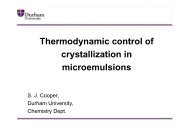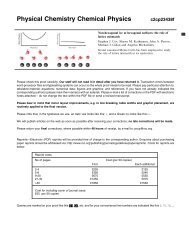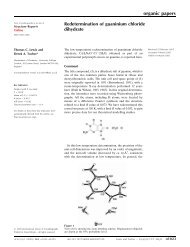ADVANCED USERS DMACRYS & NEIGHCRYS manual Manual ...
ADVANCED USERS DMACRYS & NEIGHCRYS manual Manual ...
ADVANCED USERS DMACRYS & NEIGHCRYS manual Manual ...
You also want an ePaper? Increase the reach of your titles
YUMPU automatically turns print PDFs into web optimized ePapers that Google loves.
Operands<br />
None<br />
CONP<br />
This instructs <strong>DMACRYS</strong> to relax the lattice vectors as well as the basis positions. There are 6 independent<br />
components of the bulk strain tensor which augment the 3NBAS×3NBAS matrix of basis strain components.<br />
The relaxation of both cell and atom components is carried out simultaneously. Only one of CONV and<br />
CONP may be given; this is the default directive.<br />
CONV<br />
Operands<br />
None<br />
This instructs the program to keep the lattice vectors fixed during the relaxation.<br />
PRES<br />
Operand Type F A<br />
Operand Name Pressure units<br />
This is used to change the pressure of the perfect lattice calculation. The units can be kPa, MPa or GPa. If<br />
only one operand is present, it is assumed that the units are Pa.<br />
MAXI<br />
Operand Type<br />
I<br />
Operand Name<br />
NCYCLE<br />
This defines the maximum number of iterations which will be carried out before a dump is written. The<br />
default is zero, which calculates the lattice properties at this configuration with no relaxation.<br />
MAXD<br />
Operand Type<br />
F<br />
Operand Name<br />
DSPMAX<br />
DSPMAX is the maximum permitted displacement of a coordinate per iteration. The default is 0.05<br />
Angstroms, which is set small for most problems. A larger value may improve the speed at which a problem<br />
converges, but may allow the problem to reach a region in which the structure is physically unreasonable.<br />
DSPMAX is converted to a fraction of the c lattice constant RLSCAL.<br />
The maximum rotation of a molecule is TORMAX radians, where TORMAX is set equal to DSPMAX.<br />
MAXU<br />
Operand Type<br />
I<br />
Operand Name<br />
MAXUPD<br />
MAXUPD gives the number of times the Hessian will be updated before it is recalculated. It is<br />
recommended that for large unit cells MAXU should not be set too small; a value greater than 100 should be<br />
used. The default is 1000, which effectively means that the properties will only be recalculated when the<br />
structure converges or the calculation stops for another reason.<br />
Operand Type<br />
Operand Name<br />
F<br />
LIMIT<br />
LIMI<br />
LIMIT gives the convergence test at which the relaxation stops with a valid minimisation. The minimisation<br />
will assume to have converged if all displacements in one cycle are less than LIMI. The default is 1.0E-06<br />
Angstroms, which is set very small. Most problems will be satisfactory with LIMI 0.0001.<br />
26







